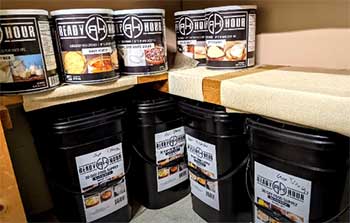I’ve spent countless miles on the road, chasing sunrises and personal bests, and I’ve learned one thing: the right shoe can make or break your run. When it comes to stability running shoes, Hoka’s Gaviota series stands out for its max-cushion design and supportive features.
In this article, I’ll compare the Hoka Gaviota 4 and Gaviota 5, sharing my experiences and insights to help you decide which shoe suits your needs. From cushioning to stability, I’ll break down the pros, cons, and key differences to guide your next purchase.
A Brief Comparison Table
| Feature | Hoka Gaviota 4 | Hoka Gaviota 5 |
| Weight (Men’s Size 9) | 11.4 oz | 10.9 oz |
| Heel-to-Toe Drop | 5 mm | 6 mm |
| Stack Height (Heel) | 40 mm | 36 mm (men), 34 mm (women) |
| Stack Height (Forefoot) | 35 mm | 30 mm (men), 28 mm (women) |
| Stability Mechanism | J-Frame | H-Frame |
| Midsole Foam | CMEVA Foam | Dual-layer CMEVA Foam |
| Meta-Rocker | Late-Stage | Early-Stage |
| Upper Material | Engineered Mesh | Creel Jacquard Mesh |
| Breathability | 4/5 (Good) | 5/5 (Excellent) |
| Price | $170 | $175 |
| Best For | Long runs, recovery, overpronators | Long runs, wider feet, supinators too |
My First Steps: Understanding The Gaviota Line
As a runner with a tendency to overpronate, I’ve always gravitated toward stability shoes that keep my feet aligned without feeling like I’m locked in a vice. The Hoka Gaviota series has been a go-to for runners like me who crave max cushioning with reliable support.
Both the Gaviota 4 and 5 are built for those long, steady miles, but they cater to slightly different needs. The Gaviota 4, released in 2022, is a tried-and-true option for overpronators, while the 2023 Gaviota 5 evolves the line with a broader appeal, addressing both overpronation and supination.
Let’s explore what makes each shoe tick.
Hoka Gaviota 4: A Stable Workhorse
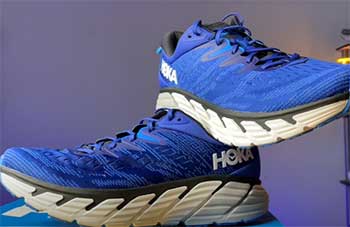
When I first laced up the Gaviota 4, I was struck by its plush, almost bouncy feel underfoot.
It’s like stepping onto a cloud that’s been trained to keep you in line.
The Gaviota 4 is a max-cushioned stability shoe, designed for runners who need support for long distances or recovery runs.
Its 40 mm heel stack and 5 mm drop create a high, supportive platform that absorbs impact like a champ.
I’ve taken these shoes on 15-mile runs, and my knees and ankles felt fresh afterward, a testament to Hoka’s signature CMEVA foam.
The J-Frame technology is the heart of the Gaviota 4’s stability. This firmer foam wraps around the heel and medial side, guiding my foot to prevent excessive inward rolling. It’s not intrusive, though—unlike some stability shoes that feel like they’re forcing your foot into submission.
The late-stage Meta-Rocker, with its gentle curve toward the forefoot, gives a smooth roll through each stride, especially helpful when I’m fatigued late in a run. I noticed this most on concrete paths, where the cushioning and rocker geometry made hard surfaces feel forgiving.
The upper is a breathable engineered mesh, which I found kept my feet cool during summer runs. The redesigned collar and tongue add a touch of luxury, with extra padding that hugs the ankle without feeling restrictive.
However, the midfoot H-Frame, a plastic insert for lockdown, can feel snug for some runners. I have narrower feet, so it worked for me, but friends with wider feet mentioned it felt a bit tight. The Gaviota 4 also comes with a heel pull tab, making it easy to slip on, and the laces thread through a loop on the tongue for a secure fit.
Durability is another strong suit. The durabrasion rubber outsole held up well after 200 miles, showing minimal wear even on abrasive surfaces like gravel. At 11.4 oz for a men’s size 9, it’s not the lightest shoe, but it doesn’t feel bulky thanks to the balanced ride.
Priced at $170, it’s a premium shoe, but I found it worth the investment for its longevity and comfort.
Pros of Hoka Gaviota 4
- Max Cushioning: The 40 mm heel stack absorbs impact, making it ideal for long runs and recovery days. My joints felt protected even after hours on the road.
- Effective Stability: The J-Frame guides the foot subtly, perfect for overpronators like me who want support without feeling controlled.
- Durable Outsole: The rubber coverage ensures the shoe lasts through hundreds of miles, a big plus for marathon training.
- Breathable Upper: The engineered mesh kept my feet cool, even on humid summer runs.
- Smooth Ride: The late-stage Meta-Rocker promotes a natural, rolling stride, reducing fatigue on long runs.
Cons of Hoka Gaviota 4
- Weight: At 11.4 oz, it’s heavier than some competitors, which I noticed during faster-paced runs.
- Snug Midfoot: The H-Frame can feel tight for runners with wider feet, limiting its appeal for some.
- Price: At $170, it’s not the most budget-friendly option, especially if you’re not a high-mileage runner.
- Adjustment Period: The 5 mm drop took a few runs to get used to, especially for heel strikers like me.
- Not for Speed: The plush cushioning and weight make it less suited for tempo runs or races.
Hoka Gaviota 5: A Modern Evolution

When I slipped into the Gaviota 5, I immediately noticed a difference. It’s lighter—10.9 oz for a men’s size 9—and feels more refined. Hoka took the Gaviota 4’s foundation and tweaked it for a broader audience, introducing the H-Frame technology and an early-stage Meta-Rocker.
These changes make the Gaviota 5 not just for overpronators but also for supinators and runners with neutral gaits who want extra stability.
The H-Frame is a game-changer. Unlike the J-Frame’s medial focus, the H-Frame spans both sides of the midsole, creating a stable platform that resists twisting. I tested this on uneven trails, and the shoe kept my foot centered, even when my legs were tired.
The dual-layer CMEVA foam adds a plush yet slightly firmer feel compared to the Gaviota 4. With a 36 mm heel stack (men’s) and a 6 mm drop, it’s still max-cushioned but slightly lower to the ground, which I found improved responsiveness.
The early-stage Meta-Rocker, positioned closer to the midfoot, gives a more dynamic push-off. I felt this most during steady-paced runs, where the shoe seemed to propel me forward with less effort. The creel jacquard mesh upper is a standout, earning a perfect 5/5 for breathability in lab tests.
I ran through a hot summer day, and my feet stayed dry and cool, thanks to the numerous ventilation holes. The toebox is wider than the Gaviota 4’s, measuring 125.1 mm in the forefoot, which is a blessing for runners with wider feet or conditions like bunions.
The Gaviota 5’s outsole uses less rubber to cut weight, but I didn’t notice any durability issues after 150 miles. At $175, it’s $5 more than the Gaviota 4, reflecting the upgraded features. However, the low 2.2 mm drop (as measured by some labs) might not suit extreme heel strikers, as I felt a slight strain in my calves initially.
Pros of Hoka Gaviota 5
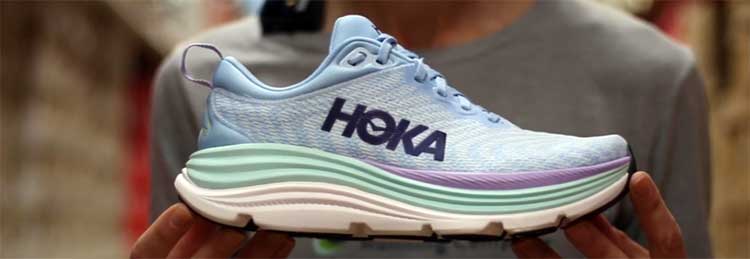
- Lighter Weight: At 10.9 oz, it’s noticeably lighter than the Gaviota 4, making it easier to pick up the pace.
- Versatile Stability: The H-Frame supports both overpronators and supinators, broadening its appeal.
- Enhanced Breathability: The creel jacquard mesh is top-notch, keeping feet cool even in hot conditions.
- Wider Toebox: The spacious forefoot accommodates wider feet, a big win for comfort.
- Dynamic Ride: The early-stage Meta-Rocker offers a smoother, more propulsive stride.
Cons of Hoka Gaviota 5
- Price Increase: At $175, it’s pricier than the Gaviota 4 and competitors like the Asics Kayano 30 ($160).
- Low Drop Concerns: The 2.2 mm drop (per some tests) may challenge heel strikers or those with calf issues.
- Less Heel Cushioning: The 36 mm heel stack is slightly lower than the Gaviota 4’s, which some runners might miss.
- Limited Outsole Rubber: The reduced rubber could wear faster for heavy runners.
- Not for Speed Work: Like its predecessor, it’s built for steady runs, not sprints.
Key Differences Between Hoka Gaviota 4 And 5
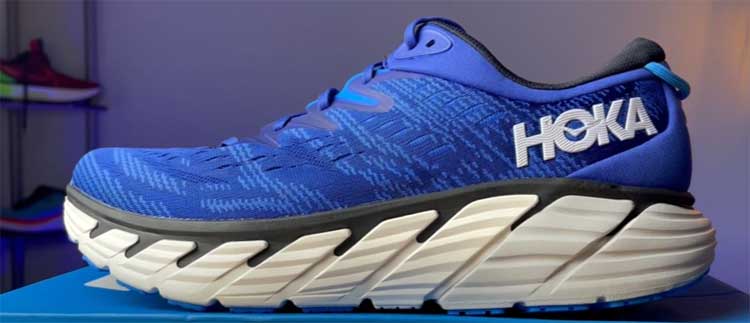
Comparing the Gaviota 4 and 5 is like choosing between a reliable old friend and a flashy new acquaintance. The Gaviota 4’s J-Frame is tailored for overpronators, guiding the foot with a firmer medial post.
I found it perfect for my long, slow runs, where the 40 mm heel stack soaked up every impact. The Gaviota 5’s H-Frame, however, feels more inclusive, supporting a wider range of gaits. During a 10-mile run, I noticed the Gaviota 5’s lighter weight and early-stage Meta-Rocker made transitions smoother, especially on rolling hills.
The weight difference—11.4 oz vs. 10.9 oz—is subtle but noticeable. I felt less drag with the Gaviota 5, especially after mile 8. The Gaviota 5’s wider toebox was a relief on hot days when my feet swelled, while the Gaviota 4’s snugger fit felt more secure for my narrow feet.
Breathability is another win for the Gaviota 5; the creel jacquard mesh outperformed the Gaviota 4’s already solid engineered mesh, keeping my feet cooler during a sweltering 12-miler.
Stack height is a key distinction. The Gaviota 4’s 40 mm heel stack offers more cushioning, which I appreciated on concrete. The Gaviota 5’s 36 mm (men’s) feels slightly firmer, which some runners might prefer for responsiveness but others might find less plush.
The drop also shifts from 5 mm to 6 mm (or 2.2 mm in some tests), affecting heel strikers differently. I adjusted to the Gaviota 5’s lower drop after a few runs, but it initially strained my Achilles.
Price is a sticking point. The Gaviota 4’s $170 tag is already steep, but the Gaviota 5’s $175 feels like a premium for incremental upgrades. If you’re on a budget, the Gaviota 4 might be a better value, especially if you find it on sale.
However, the Gaviota 5’s versatility and modern features justify the cost for runners needing a shoe that handles diverse conditions.
My Experiences With Hoka Gaviota 4 And Gaviota 5
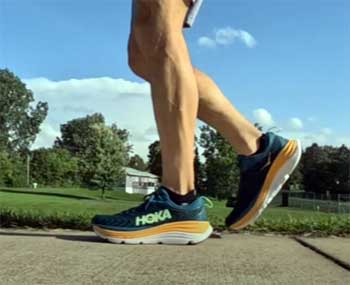
To really understand these shoes, I put them through their paces.
I ran 200 miles in the Gaviota 4 over three months, mostly on asphalt and concrete, with some crushed gravel trails.
The cushioning held up beautifully, and the J-Frame kept my overpronation in check.
I used them for recovery runs after intense speed sessions, and they never let me down.
The only gripe was the weight, which I felt during a rare tempo run—definitely not their strong suit.
The Gaviota 5 got 150 miles of testing, including road runs, light trails, and even some walking shifts at work (I’m on my feet for 8 hours some days). The H-Frame impressed me on uneven surfaces, where I felt stable even when dodging roots.
The lighter weight and early-stage Meta-Rocker made it feel more lively than the Gaviota 4, especially on steady 6-mile runs. However, I noticed slight calf tightness early on, likely due to the lower drop. The breathability was a standout—my feet stayed dry even during a 90°F run.
I also lent both pairs to running buddies with different foot types. My friend with wide feet found the Gaviota 5’s toebox a godsend, while the Gaviota 4 felt restrictive.
Another friend, a supinator, loved the Gaviota 5’s H-Frame for its balanced support but found the Gaviota 4 too focused on medial stability. These real-world tests confirmed the Gaviota 5’s broader appeal but also highlighted the Gaviota 4’s niche excellence for overpronators.
Who Should Choose Which?
The Gaviota 4 is your pick if you’re an overpronator who loves max cushioning for long runs or recovery days. Its J-Frame and 40 mm heel stack make it a tank for soaking up miles, especially on hard surfaces.
If you’re on a budget or don’t need the latest tech, it’s a solid choice, especially if you find it discounted.
The Gaviota 5 suits a wider audience—overpronators, supinators, or neutral runners needing stability. Its lighter weight, wider toebox, and H-Frame make it versatile for varied terrains and foot shapes.
If you value breathability and a more dynamic ride, the Gaviota 5 is worth the extra $5, especially for runners with wider feet or those tackling longer walks.
Comparing To Competitors
I also compared both Gaviotas to rivals like the Asics Kayano 30 ($160) and Saucony Guide 17 ($140). The Kayano 30 offers similar max cushioning but with a denser midsole and 4D Guidance System, which I found slightly more stable than the Gaviota 5’s H-Frame but less plush.
The Guide 17 is lighter (9.9 oz) and has a higher 6 mm drop, making it snappier for faster runs, but it lacks the Gaviota 5’s toebox width. The Gaviota 4 holds its own against these but feels heavier, while the Gaviota 5 competes closely, though its price is a touch high.
Frequently Asked Questions (FAQ)
The Gaviota 5 is lighter (10.9 oz vs. 11.4 oz), features an H-Frame for broader stability (vs. J-Frame for overpronation), and has an early-stage Meta-Rocker for a dynamic ride (vs. late-stage). It also has a wider toebox and better breathability but a slightly lower heel stack (36 mm vs. 40 mm).
The Gaviota 4 excels for overpronators needing max cushioning for long runs, recovery days, or walking. Its J-Frame and 40 mm heel stack provide support and impact absorption, ideal for marathon training or all-day wear.
Yes, the Gaviota 5’s wide base, H-Frame, and plush cushioning support plantar fasciitis by reducing strain and stabilizing the foot. Consult a podiatrist to ensure it fits your specific needs.
The Gaviota 4 suits overpronators needing max cushioning for long runs or recovery. The Gaviota 5 is ideal for runners or walkers with wider feet, overpronators, supinators, or those seeking versatile stability and comfort.
Final Thoughts
You’re standing at the crossroads of two fantastic shoes, and I’ve been there, lacing up both the Hoka Gaviota 4 and 5, feeling the difference with every step. The Gaviota 4 is your loyal companion for long, plush miles if overpronation is your main concern.
The Gaviota 5, with its lighter weight and versatile H-Frame, invites you to explore a broader range of runs and terrains. Whichever you choose, you’re getting Hoka’s signature comfort and durability.
Try them on, take a few strides, and let your feet decide which Gaviota will carry you to your next finish line.

